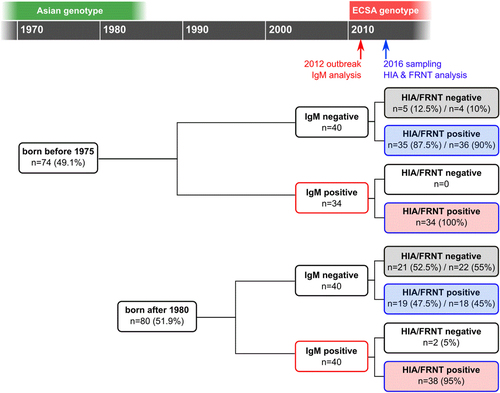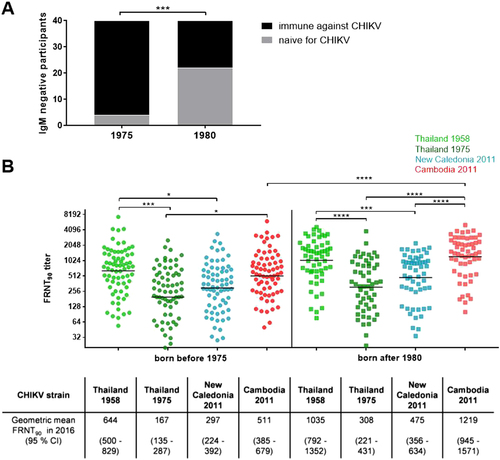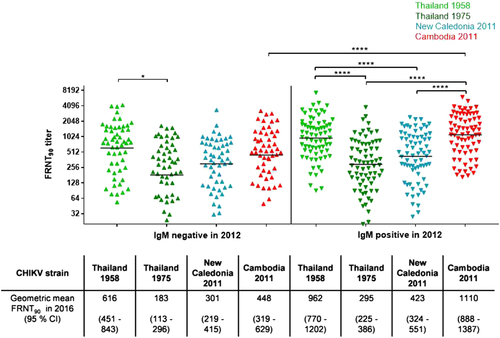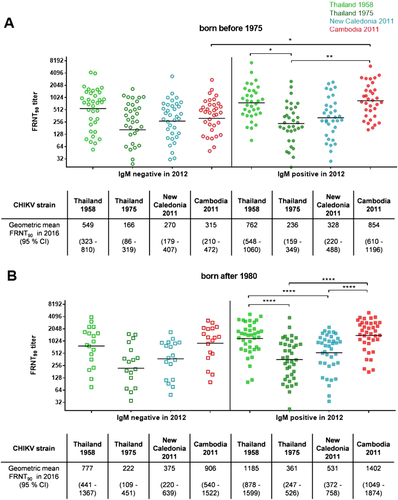Figures & data
The recruitment included a comparable number of individuals born before 1975 (n = 74) and after 1980 (n = 80), as well as numbers of infections (IgM positive) confirmed in 2012. Based on the IgM status from 2012 and the antibody status in 2016 (investigated by HIA and FRNT), the study participants could be classified as individuals who remained naive in 2016 (gray shaded boxes), individuals infected during the outbreak in 2012 (red shaded boxes), and study participants with CHIKV immunity acquired at an unknown time point (blue shaded boxes). All criteria allowed for a separate analysis of subgroups, designated subgroup 1 based on the age of the study participants, subgroup 2 based on the IgM status in 2012, and subgroup 3 including both age and 2012 IgM status

Results of the three chikungunya serological assays used (MAC-ELISA, HIA, and FRNT) among the study participants (n = 154)
HIA and FRNT90 titers among the study participant subgroups (n = 154)
a Study participants who were not infected in 2012 (IgM negative) and were antibody positive in 2016 (positive FRNT90 titer; black bars) as well as individuals remaining naive in 2016 (negative FRNT90 titer; gray bars), stratified by age. Asterisks indicate statistically significant differences in the proportions of participants (***p < 0.001; χ2 test). b Individual FRNT90 titers (with geometric mean) of study participants with neutralizing antibodies (n = 126), stratified by age group (circles: born before 1975, n = 70; squares: born after 1980, n = 56). FRNT90 titers against the three Asian genotype strains from Thailand (TH 35: light green; TH 1455-75: dark green) and New Caledonia (NC-2011-568: blue) as well as the Cambodian ECSA IOL strain from 2011 (V1024306_KH11_PVH: red). Asterisks indicate statistically significant differences in mean FRNT90 titers between the distinct virus strains (*p < 0.05; ***p < 0.001; ****p < 0.0001; one-way ANOVA, Tukey’s multiple comparison test)

Individual FRNT90 titers (with geometric mean) of study participants with neutralizing antibodies (n = 126), stratified by participants infected in 2012 (IgM positive, n = 54; down-pointing triangle) and participants not infected in 2012 (IgM negative, n = 72; up-pointing triangle). FRNT90 titers against the three Asian genotype strains from Thailand (TH 35: light green; TH 1455-75: dark green) and New Caledonia (NC-2011-568: blue) as well as the Cambodian ECSA IOL strain from 2011 (V1024306_KH11_PVH: red). Asterisks indicate statistically significant differences in mean FRNT90 titers between the distinct virus strains (*p < 0.05, ****p < 0.0001; one-way ANOVA, Tukey’s multiple comparison test)

Individual FRNT90 titers (with geometric mean) of study participants with neutralizing antibodies (n = 126). a FRNT90 titers of study participants born before 1975 divided by IgM status in 2012 (open symbols: negative; filled symbols: positive). b FRNT90 titers of study participants born after 1980 stratified by IgM status in 2012 (open symbols: negative; filled symbols: positive). FRNT90 titers against the three Asian genotype strains from Thailand (TH 35: light green; TH 1455-75: dark green) and New Caledonia (NC-2011-568: blue) as well as the Cambodian ECSA IOL strain from 2011 (V1024306_KH11_PVH: red). Asterisks indicate statistically significant differences in the mean FRNT90 titers between the various virus strains (*p < 0.05; **p < 0.01; ****p < 0.0001; one-way ANOVA, Tukey’s multiple comparison test)

Comparison of E1 and E2 amino acid sequences of the CHIKV strains used for neutralization assay
